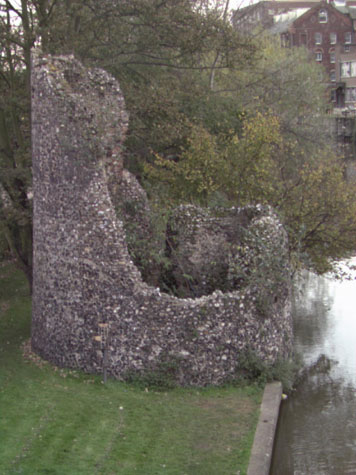City walls survey
36 Wall Below Kings Street and Boom Towers
This part of the Survey was completed in 2005
The Devil's Tower (Eastern Boom Tower)IntroductionThe Devil's Tower stands isolated on the eastern bank of the River Wensum without any attached walls connecting it to any other city fortification, in a similar manner to the Cow Tower to the north in the Great Hospital Meadow[1]. The Cow Tower was designed solely as an artillery platform and it has been accepted that in the event of any hostile force gaining the city side of the river it could not have been defended . The same circumstance would have attached to the Devil's Tower which is not only outside the medieval city boundary, but had no ditch or any other defensive earthwork. It was ignored during Ketts Rebellion of 1549, probably because taking the structure would have had no practical purpose, and it would appear that it was designed and built solely to carry the iron staple for the chain which spanned the river. It was constructed for Richard Spynk, probably after 1333 when Edward III settled a trade dispute between Norwich and Great Yarmouth, but before 1343, and was used to regulate river traffic entering and leaving the city. The western boom tower (the windlass tower) directly opposite on the west bank had the windlass for raising and lowering the chain and that tower is known to have been occupied by the tower keeper, but there is no record at all of the Devil's Tower ever having been occupied, although it must have been manned by watchmen in time of tension. In 1386 there were certainly two wardens of the tower, Richard Drewe and John Bray. It is a virtually unique structure in England, the only other free-standing tower erected for the same purpose having been built at York at roughly the same time in the early 14th century . That has since been demolished, so no comparison is possible, but the means of access is known from James Starl's description of 1832. Security in that respect was better than at the Cow Tower which has a doorway on the ground floor facing the city, but the Devil's Tower had an interesting arrangement of a door facing the river and pointing slightly upstream with its sill five feet above the water. Access must have been a delicate business, but it would make hostile entry virtually impossible directly under the crossbows of men in the windlass tower at point-blank range. The tower had two internal floors linked by a brick and flint staircase, and of all the towers of Norwich it is unique in having three projecting bartizan turrets rising above the crenellated parapet. That and its slightly later date suggest a different master mason was the designer. |

